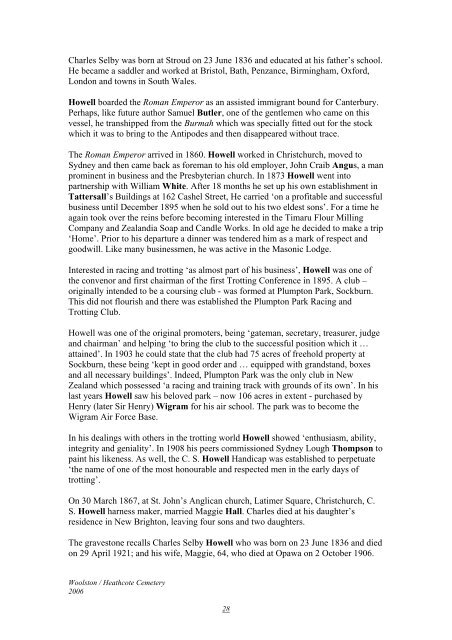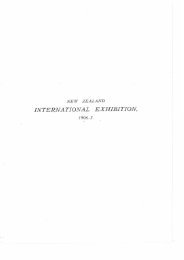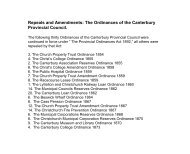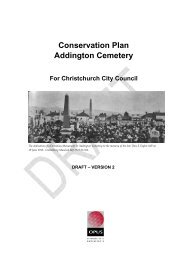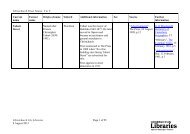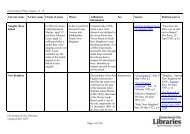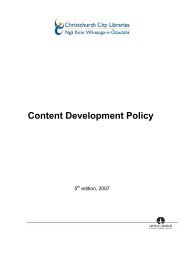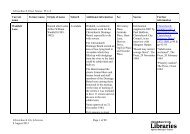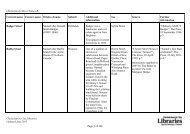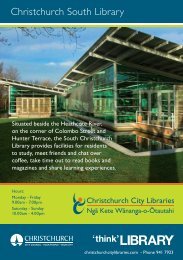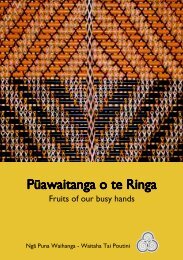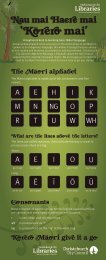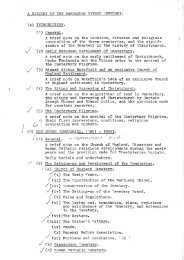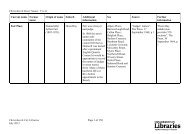Woolston / Heathcote Cemetery Tour - Christchurch City Libraries
Woolston / Heathcote Cemetery Tour - Christchurch City Libraries
Woolston / Heathcote Cemetery Tour - Christchurch City Libraries
Create successful ePaper yourself
Turn your PDF publications into a flip-book with our unique Google optimized e-Paper software.
Charles Selby was born at Stroud on 23 June 1836 and educated at his father’s school.<br />
He became a saddler and worked at Bristol, Bath, Penzance, Birmingham, Oxford,<br />
London and towns in South Wales.<br />
Howell boarded the Roman Emperor as an assisted immigrant bound for Canterbury.<br />
Perhaps, like future author Samuel Butler, one of the gentlemen who came on this<br />
vessel, he transhipped from the Burmah which was specially fitted out for the stock<br />
which it was to bring to the Antipodes and then disappeared without trace.<br />
The Roman Emperor arrived in 1860. Howell worked in <strong>Christchurch</strong>, moved to<br />
Sydney and then came back as foreman to his old employer, John Craib Angus, a man<br />
prominent in business and the Presbyterian church. In 1873 Howell went into<br />
partnership with William White. After 18 months he set up his own establishment in<br />
Tattersall’s Buildings at 162 Cashel Street, He carried ‘on a profitable and successful<br />
business until December 1895 when he sold out to his two eldest sons’. For a time he<br />
again took over the reins before becoming interested in the Timaru Flour Milling<br />
Company and Zealandia Soap and Candle Works. In old age he decided to make a trip<br />
‘Home’. Prior to his departure a dinner was tendered him as a mark of respect and<br />
goodwill. Like many businessmen, he was active in the Masonic Lodge.<br />
Interested in racing and trotting ‘as almost part of his business’, Howell was one of<br />
the convenor and first chairman of the first Trotting Conference in 1895. A club –<br />
originally intended to be a coursing club - was formed at Plumpton Park, Sockburn.<br />
This did not flourish and there was established the Plumpton Park Racing and<br />
Trotting Club.<br />
Howell was one of the original promoters, being ‘gateman, secretary, treasurer, judge<br />
and chairman’ and helping ‘to bring the club to the successful position which it …<br />
attained’. In 1903 he could state that the club had 75 acres of freehold property at<br />
Sockburn, these being ‘kept in good order and … equipped with grandstand, boxes<br />
and all necessary buildings’. Indeed, Plumpton Park was the only club in New<br />
Zealand which possessed ‘a racing and training track with grounds of its own’. In his<br />
last years Howell saw his beloved park – now 106 acres in extent - purchased by<br />
Henry (later Sir Henry) Wigram for his air school. The park was to become the<br />
Wigram Air Force Base.<br />
In his dealings with others in the trotting world Howell showed ‘enthusiasm, ability,<br />
integrity and geniality’. In 1908 his peers commissioned Sydney Lough Thompson to<br />
paint his likeness. As well, the C. S. Howell Handicap was established to perpetuate<br />
‘the name of one of the most honourable and respected men in the early days of<br />
trotting’.<br />
On 30 March 1867, at St. John’s Anglican church, Latimer Square, <strong>Christchurch</strong>, C.<br />
S. Howell harness maker, married Maggie Hall. Charles died at his daughter’s<br />
residence in New Brighton, leaving four sons and two daughters.<br />
The gravestone recalls Charles Selby Howell who was born on 23 June 1836 and died<br />
on 29 April 1921; and his wife, Maggie, 64, who died at Opawa on 2 October 1906.<br />
<strong>Woolston</strong> / <strong>Heathcote</strong> <strong>Cemetery</strong><br />
2006<br />
28


